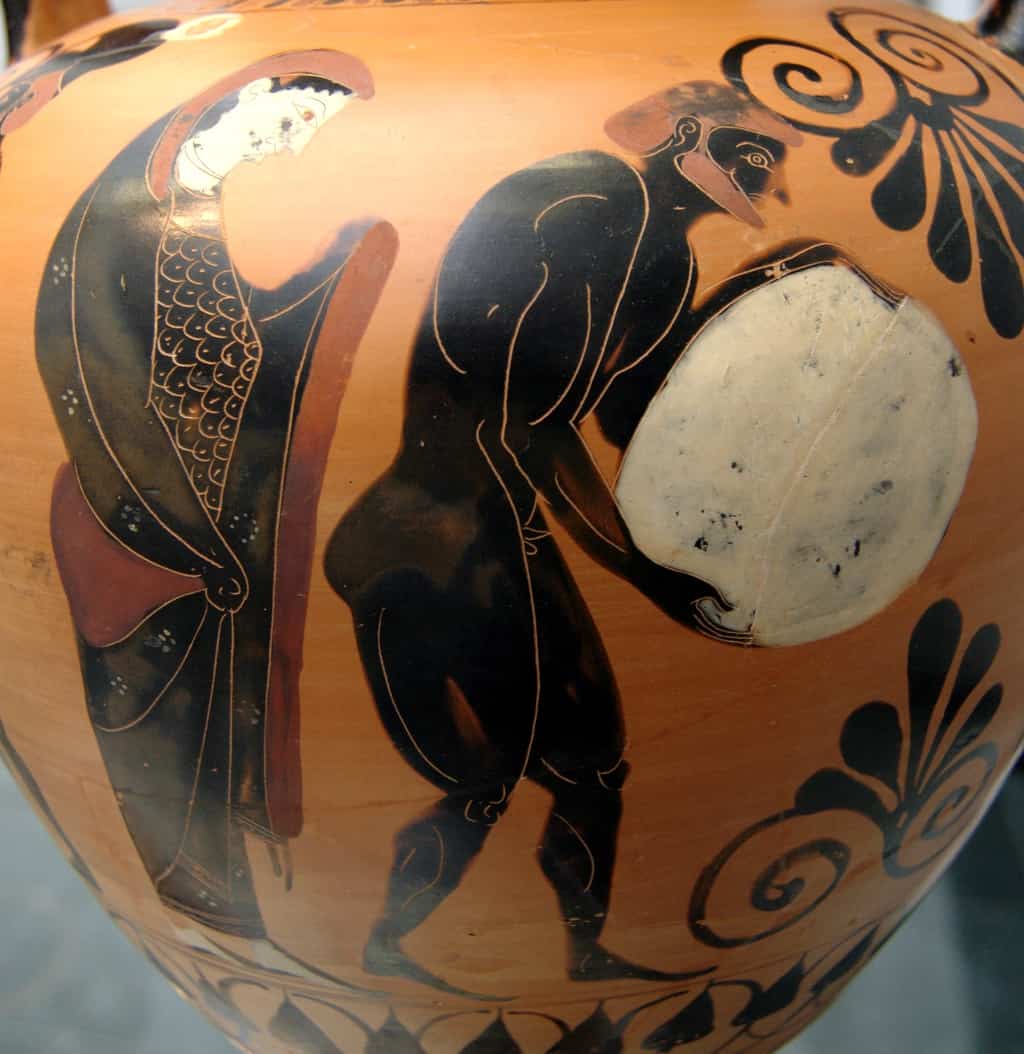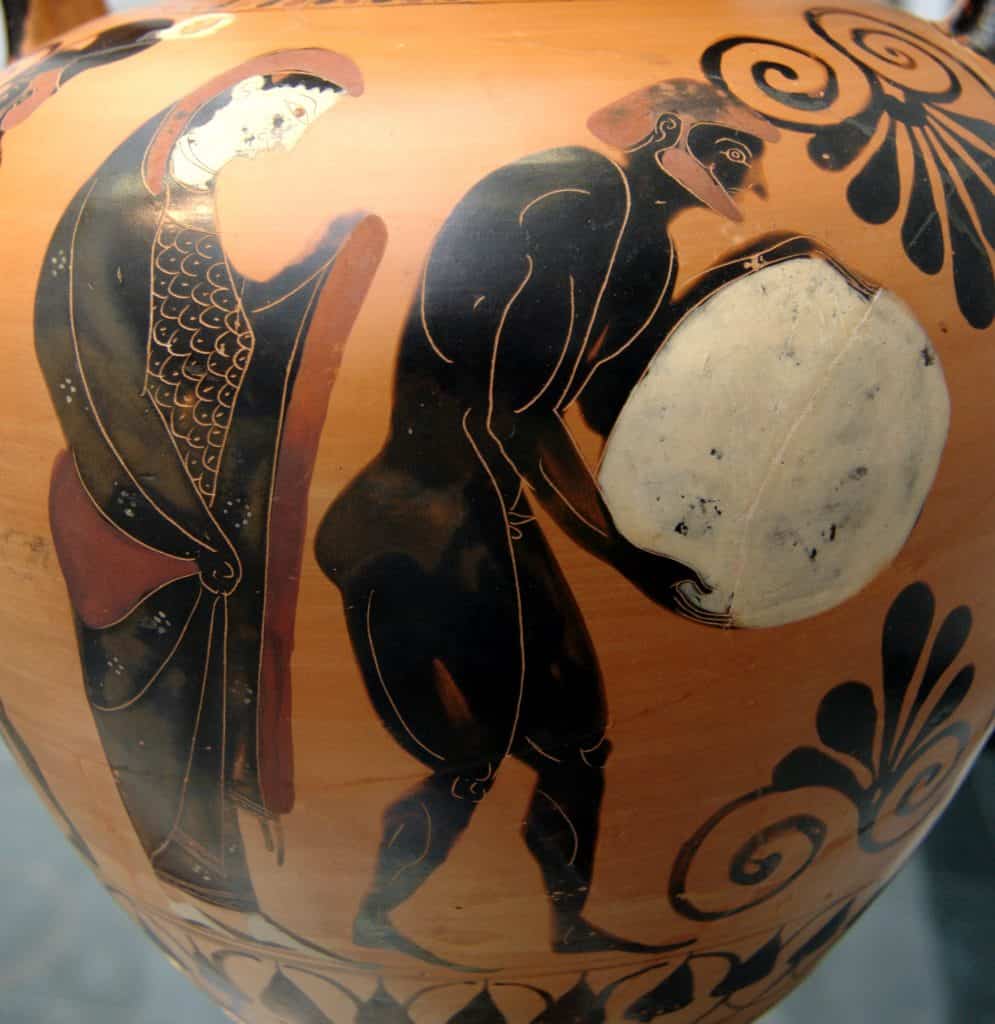Work equals force by distance, where a single newton of force represents the amount of force needed to move one kilogram one meter. The equivalent imperial unit is the foot-pound which is self-explanatory.

Image: Sisyphus: ‘In Greek mythology Sisyphus or Sisyphos was the king of Ephyra. He was punished for his self-aggrandizing craftiness and deceitfulness by being forced to roll an immense boulder up a hill only for it to roll down every time it neared the top, repeating this action for eternity.’ Wikipedia
An example, if you chose a pair of shoes which each weighs 100 grams (1/10th of a kilogram) more (than another shoe) and you walk 20,000 half metre steps in a day, you have moved the equivalent of an extra tonne (1,000kg) during the course of the day (.1 x .5 x 20,000) a distance of one metre. And that’s each shoe!
That is a lot of extra effort. If I asked you to shovel a tonne of manure from this pile here to that one a metre away there you would think it was a lot of work, and maybe wouldn’t want to do much else for the rest of the day! (It would be a pile approximately a cubic metre/yard say 3′ x3′ x 3′). But that’s just what 100 grams in each of a pair of shoes adds up to, yet you are likely carrying several kilograms extra somewhere in your kit! How many tonnes of s—t is that?
Let me simplify that: if you multiply the savings in grams by 10 (or 20 for pounds) you will get an answer that is the equivalent to moving the same weight in kilograms (pounds) one metre (yard). So a saving of 100 grams = 1000, kg or 2,000 lbs moved a metre. ‘So a saving of 10 grams now doesn’t seem so silly does it when you see that it is the same as shifting 100 kg (200 lbs) one metre (yard)!’ per hiking day in energy terms, energy which has to be carried in grams of food and calculated in calories of food carried.
This is (incidentally) why I consider myself to be much fitter than you are – because I am overweight. Carrying around all that extra weight represents a lot of extra work each day – which clearly keeps me fitter!
When you want to begin lightening your load (aside from dieting) you should start with your feet and work upwards. Your feet do much more moving both horizontally and vertically than the rest of you (aside from your arms) which is why the old adage is that a pound of weight on your feet is equal to 10/20 lbs on your back.
The above calculation considers only the horizontal work involved. The vertical work involved is similar. You are lifting that extra 100 grams approx 6′ or 15 cm 20,000 times a day, the equivalent of lifting 1 tonne (1000kg) to a height of 1 foot (30 cm) Try that as a dead-lift! Similarly if you are using ‘conventional’ hiking poles at about 250 grams each instead of ultralight ones such as these or these Naturehikes which will save you 100-150 grams each, you are lifting each of those poles perhaps 1′ every stride – so again the equivalent in a day of trying to dead-lift that one-tonne weight!
Of course hiking poles may take (perhaps 40%) of the effort off your legs and they also make you (sort of) four-legged so less likely to have (perhaps disastrous) falls. Why I use them so much now that I am quite decrepit. They do (incidentally) help a lot (attention hunters!) with those heavy meat carry-outs – if you can sling your rifle or have a take-down. I have found them very useful for that, and when you are very tired going uphill after a long day’s hunt.
Mind you I never used them at all until I was 60. I considered them quite ‘dandified. However I borrowed (one – should have taken both) from Della when I walked in for three days to pack raft the Seaforth River in Fiordland in 2009, as I was carrying (for me) quite a heavy load – probably 13 kg for the 9 day trip including teh pack raft. It was such a help (saved me from a nasty fall in the downhill climb to Loch Marie) that I have used them ever since – even if they make me look a bit of a sissy!
Those tough bulletproof waterproof leather hunting boots which likely weigh a kilogram each (dry!) can be replaced by shoes which weigh as little as 200 grams each (such as Topos – for track walking), but 400 grams each will get you shoes which are quite tough and safe enough, like Keen Targhee 2s for going bush or hunting in. That 600 grams (each) subtracted from a kilogram equals not having to move six tonnes during your hiking/hunting day. I am talking about a seriously big pile of manure now!
I know many of you, hunters particularly are wearing shoes/boots which weigh over a kilogram, (more particularly when wet!). How many of you completely soak your boots then weigh them? I know I do. The ‘wet boot’ problem is a particular drain on energy which I have discussed a number of times before. It seems to me that few if any manufacturers figure the wet weight of their footwear or how quickly it diminishes over time with distance.
Over the years I have bought a number of pairs of boots which weighed up to a kilogram of weight when wet each! (You can have them for free if you want, nearly new in a box on the verandah). If you have accidentally bought such a pair of boots immediately before a trip without trying them out you will really regret it after a hundred kilometers – or less!
Though I ‘know better’ I still managed to do this before a 2016 walk along the South Coast Track in NZ’s Fiordland. My old Keen Targhees were rather worn. I could only source an alternative pair of Keens (different model) at the last minute. It never occurred to me that the manufacturer would have changed the hydrological behaviour of their footwear, but I weighed these boots as being 900 grams (each) heavier wet than dry when I came home – a much tireder man than I set out. Never buy new boots before a hike!
Next look at your socks, gaiters, trousers, over-trousers, how free moving your trousers and any undergarments are, not forgetting the things you have in your pockets then on your arms and in your hands as these two limbs also move over a greater distance and height than does the rest of you. I bet you can (collectively) save the effort of moving up to ten tonnes of junk just by lightening up on your arms and legs alone!
If you have made the switch to hiking shoes eg I use Keen’s Voyageurs (non-waterproof) or Targhee 2s (waterproof) and on track trips I may use the Topos. you have also probably found that you do not need such thick socks as you used to. The lightest (Holeproof Heroes) woolen socks are now good enough for me during an active day (at camp at night is different – down socks are great!) as compared with some very heavy eg Wigwams I used to wear. You can also (usually) lighten and shorten the laces. The Darn Tough socks are brilliant by the way. You only need the lightest ones.
Why are you wearing those gaiters – if you are? For most purposes (eg keeping leeches from your ankles) you can tuck your trousers into your socks. I only ever wear gaiters when absolutely necessary. If there is a really lot of debris or mud which is getting into your shoes think about buying a pair of ultralight gaiters. These can weigh as little as 50 grams a pair compared with a typical heavy duty pair which might weigh 250 grams plus each!
I have published dozens and dozens of ideas for lightening your load – many of them very cheap or DIY. Try searches in the facility on the bottom left hand corner of the page for ‘ultralight’, ‘budget’ ‘DIY’ etc.
For an optimum energy expenditure all your load should be carried at your centre of gravity ie your lower back. See Backpack Tips and Tricks. The further any weight is from that point the more work is involved in moving it. You must bear in mind that every extra kilogram (2.2 pounds) transported just one 1 km (.6 of a mile) represents moving a ten tonne (ton) weight from this spot here to this one here one metre (yard) away – something which you would only rarely try to do – yet you think nothing of that extra kilogram in your pack and expect to move it 10-20 km a day!
If you are going on a walk (per day of say 20 km (12 miles) and you have a 15 kg skin-out weight instead of a 10 kg one you are going to be moving that extra 5 kg x 20,000 metres – the same as moving one hundred tonnes one metre! That is a huge amount of work! I am much too lazy to want to do that!
For a start all that work is going to require a lot of extra energy which means weight in food. If you are carrying a modest (under 10 kg skin-out weight including food and water) of say 10 kg (22 lbs) you may only need 2500-3,000 calories (all I ever carry, say 4-500 grams per day – but if you insist on doing twice as much work you are going to have to carry twice as much food – which also weighs twice as much. This behaviour is just self-defeating. There comes a point where you need the weight in food to carry the (extra) weight in food!
See Also
Dusky Track: Canoeing the Seaforth


Some good food for thought. Thanks. I couldn’t agree more with trail runners being suited to.on track walking… never again will I spend a day going cross camber along a hill hunting with trail runners.
I think you will find that the difference between Topos at 200 grams, Keens at 400 and Redbacks at 600 (as compared with many much heavier shoes) is the lest of what I am talking about here Stuart. Why i am always really delighted to figure a way i can save an unnecessarily 10 grams! Cheers, Steve.
Hi Steve. I enjoyed this post in its entirety and will be pondering it next time I’m repacking my bag alongside some scales. The bit of context you provided about the topos stood out to me pleasingly.
Whilst I don’t share the same appreciation of finding 10g (yet) I am slowly getting there!
Try the straw idea! And you might be better with one of these: https://www.theultralighthiker.com/2020/04/30/superlight-hunting-pack-193-grams/ or these: https://www.theultralighthiker.com/2020/06/06/ultralight-ultracheap-deer-hunting-a-ripping-yarn-or-two/ Cheers, Steve